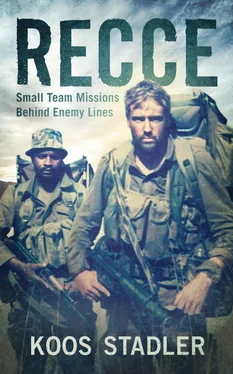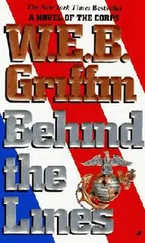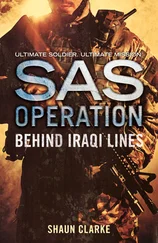Later on, after I had selected and trained the first group of Baraquenas from A Company, Xivatcha Shekamba and Chimango Kanyeti became my permanent team buddies. I soon realised that the Baraquenas were equally well adapted for reconnaissance work, having been exposed to the same hostile conditions as the Vasquelas in Angola. I deployed on a series of reconnaissance missions with them, and today I have to admit that I owe my survival to both of them.
A buddy pair typically consisted of one Bushman and one white operator, as the natural skills and instincts of the Bushmen were considered critical for our survival. However, most of the Bushmen soldiers were still illiterate, and their level of both English and Afrikaans left much to be desired. While they could set up a radio and convey elementary messages, they could not draft reports or encode and transmit messages. It was therefore essential to have a combination of Bushman and white buddy pairs in the team.
Back then, the size of a team was determined by practical considerations. We wanted the team to be as small as possible, as the conventional six-man team was considered cumbersome and left far too many tracks. The four-man team appeared to be the best size for tactical reconnaissance.
Buddy pairs could also act independently when required. For the final approach to a target, for example, one buddy pair could stay behind in a hide, set up the HF radio and act as both relay station and emergency rendezvous point (better known as a crash RV) for the recce team. The recce team, in turn, could leave their packs in the hide and do their final approach in light order. Very high-frequency (VHF) radio communications would be maintained between the two groups. If the recce team could not locate the target, they would return to the hide and the whole team would move further into the suspect area. This procedure, called “caterpillaring”, would be repeated until confirmation could be obtained that the enemy was either present or not.
Over the years that I served with 31 Battalion recce wing, I steadily built up my knowledge of guerrilla operations. The tactics and skills required for reconnaissance missions became second nature, and I would eventually develop my own philosophy and create a unique concept for these missions. This tactical foundation served me in good stead in my later career in Special Forces, and would eventually form the basis for doctrine we conveyed during training.
It remained a challenge to infiltrate undetected through hostile and often populated areas towards a target, and we constantly tested new ideas and developed techniques to try to outwit the enemy. Consequently, the means of infiltration towards a target area was subject to much deliberation. While parachute infiltration had always been considered, it had never actually been done, because the Bushmen had never been exposed to airborne operations and had not done the training.
That was why, at the end of 1979, I was sent to Bloemfontein to do the basic parachute course at 1 Parachute Battalion – with six Bushmen. We prepared ourselves well, and by the time the course started we were super-fit. The time in South Africa turned out to be an astonishing experience, as the men from the bush had never even seen a high-rise building, nor a lift or an escalator. For most of them, a tar road was a novelty, while the many shops and businesses were almost too much to comprehend. Whenever I took them to town, the seven of us had to hold hands to stay together, especially when crossing roads.
As it was the height of the apartheid era, I tried to prepare them beforehand for what was to come. But even I was shocked by the way African people were treated, whether by shopkeepers, train conductors or simply people on the street. More than once I had to intervene in a shop and tell a clerk that the Bushmen were with me and that I wanted to buy the items for them. It was embarrassing in the extreme, as racism was completely foreign at Omega, and I had difficulty in making them understand how a system like that could rule our society.
The parachute course did not go down well with the Bushmen. Although they were exceptionally fit, they could not pass the heavy lifting and power exercises of the PT course – the two-week physical training programme that served as selection for parabats. I was disappointed, as we had all trained together at Omega, and I found the PT course a breeze. I even had the time and energy to spend my evenings with the pretty girls of Bloemfontein!
Four of the Bushmen eventually went on to do the actual jumping phase, but again, to my disappointment, they could not master the landing drills. Only one of them qualified, though we often let the rest of the group jump once back in the Caprivi.
At the end of the course, we made our way back to Pretoria by train. At Germiston station we had to transfer to another train, and I warned them beforehand that the train, an urban commuter-type, would stop for only a few seconds. We had to get on as quickly as possible and there would be no time to waste with our luggage. When the train approached, we were standing at the ready on the platform. As the door opened, I threw in my luggage and some of the Bushmen’s and then stepped on board. Two of them followed me, but when the train suddenly started to pull away they decided to stick with their buddies on the platform and jumped off before the doors could close, leaving me with half the luggage on the train. As I looked out of the window, they were clutching each other in a pathetic huddle on the platform.
Since all of my luggage was on the train, I had no option but to stay. I was really worried, as I knew the Bushmen had no clue about where to go, and we hadn’t agreed on an emergency RV beforehand, as we always used to do. I only managed to get off about four stations later. I left the luggage with another soldier going to Pretoria and took the next train back to Germiston. But there was no sign of my comrades, and apparently no one had seen them.
In low spirits, I took the next train to Pretoria. But, lo and behold, as the train pulled in to the station that evening, there they were – standing by their luggage, smiling and waving at me. They even made fun of me for arriving so late.
Back at the unit, we soon settled into the normal routine of training, waiting for deployment orders for the next mission, and then preparing and rehearsing for the job. The road construction base at Chetto, about 60 km from Omega, was the ideal venue for many of our rehearsals, as it provided a real-life target in a thickly vegetated area.
During one such rehearsal at Chetto, with Xivatcha Shekamba, I got a nasty wake-up call and was taught a lesson I would not soon forget. After observing the “enemy” for some time, we infiltrated the base by crawling under the double fencing during the small hours of the night, leaving a trail as prominent as a bulldozer’s. We settled down under an upturned engineer’s boat right in the centre of the camp, from where we watched the base awakening and even had a giggle as we observed their morning parade from our snug little hide.
Our happy state was not to last for long, because soon after the parade the security section of the base discovered our entry point and followed our tracks. With shouts of “AWOL!” and “Lazy bastards!” the trackers challenged us to vacate our position. Soon the whole engineer community had gathered around us, and it was rather embarrassing to crawl out and face the daylight. The base commander pretended that he was not aware of the exercise. He alleged that he thought we were real enemy and consequently permitted a fair measure of “manhandling” by his troops. However, he ensured a happy ending to our misfortune by taking us for some refreshments in the camp bar, and then giving us a free ride back to Omega.
Читать дальше












